One hundred years ago, in the summer of 1923, 16 First Nations chiefs, a large group of government officials and a smattering of interpreters gathered around a document that would shape the future of the úxwumixw, the several Squamish communities that lived in British Columbia.
The political amalgamation agreement declared that the chiefs’ 16 villages would assemble as one governing body, and with the signing of the document the Sḵwx̱wú7mesh Úxwumixw (Squamish Nation), as we now know it, was born.
This July, the Squamish Nation will celebrate its centennial year with a month-long hosting of events.
Designed to showcase the Nation’s culture, heritage and history, the events, funded with $129,700 of the government’s B.C. Fairs, Festivals and Events (BCFFE) fund, span the modern and the traditional. There will be canoe races, evenings dedicated to drumming and singing, lacrosse games, talent shows, cultural activities, ceremonies, and, on Amalgamation Day itself, July 23, an all-encompassing festival.
“This year is a big year for our people,” says Squamish Nation elected council member Sxwíxwtn (Wilson Williams). “The whole month of July is about how we’re going to celebrate and really hold each other up as a Nation, empower our people, and educate them and others on our past.”
The history of the Squamish people, Williams adds, is as rich as it is long.
Prior to the Indian Act in 1876, the traditional territory of the Squamish people spanned 6,732 square kilometres, with multiple transient communities living across the province from Burrard Inlet into Howe Sound.
“People had never even thought of reserves until the government came, it was more like how do we live on the land and where,” says Williams, adding how one community had been lured to Capilano, for example, by the Capilano River, abundant with clams and trees and “all these beautiful things that we survived off.”
Following the passing of the Indian Act, these transient groups were designated to specific areas as a result of the government’s strictly enforced reserve system. Some reserves, like the Kitsilano Indian Reserve, or Sen̓áḵw, had been erected only to be promptly torn down.
In 1913, Sen̓áḵw was the last in a string of village sites to be coercively sold to government officials. The families that resided there, along with a small collection of their personal belongings, were forcibly removed from their homes, loaded onto a barge and towed across the inlet to the remaining Squamish reserves, as the village of Sen̓áḵw was torched.
“When we got kicked out and put on that barge, and on that very same day our village was burnt down, that’s when the leaders and hereditary chiefs decided that something had to be done,” says Williams. “What came after that was ten years of solid, hard work to protect what we had left, and unify those remaining 16 villages.”
Williams credits the merging of those villages as being the reason why the Squamish community has thrived over the past century. As the second largest nation in British Columbia, the Squamish Nation now boasts more than 4,000 members, he says.
He hopes those who attend Amalgamation Day events this July remember the struggles and strife of the Nation in equal measure as the successes and milestones. It is a celebration after all, he says, and there is certainly plenty to raise a toast to.
One of the biggest successes to celebrate would be the cultural renaissance that the Nation is currently experiencing, especially in regards to revitalizing the Skwxwú7mesh Sníchim (Squamish Language).
On other notable achievements, Williams says, include the Hiy̓ám̓ Housing initiative, a non-profit organization that develops and manages affordable housing for Nation members, and the MST real estate development corporation, created in collaboration with the Tsleil-Waututh and Musqueam Nations.
Just this year the Squamish Nation announced it would be developing 350 acres of its land in North and West Vancouver, the Sunshine Coast and Squamish, to create further affordable housing and cultural amenities for members, including a traditional longhouse and community centre.
“Where we are today, what we have achieved and the evolution of the empowerment we have that uplifts and brings pride to our people, that is at a place it’s never been,” says Williams.
He says the Nation is setting precedents on how confidently it can look back at its own history, but it still has to go back further, before colonialism and before the Indian Act, so its people can understand “how we lived, how we survived, how we were connected to our lands” but most importantly, he says, “how far we’ve come.”
In the lead up to Amalgamation Day and throughout the month of July we'll be reporting on all the events and cultural happenings taking place for the 100th anniversary celebration. Check back here for more stories.
Mina Kerr-Lazenby is the North Shore News’ Indigenous and civic affairs reporter. This reporting beat is made possible by the Local Journalism Initiative.



